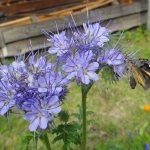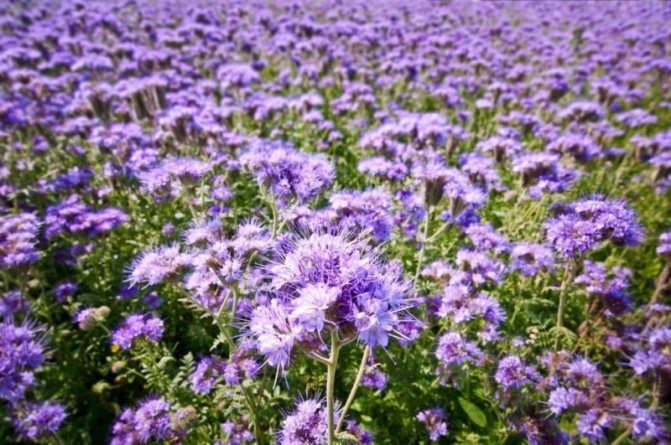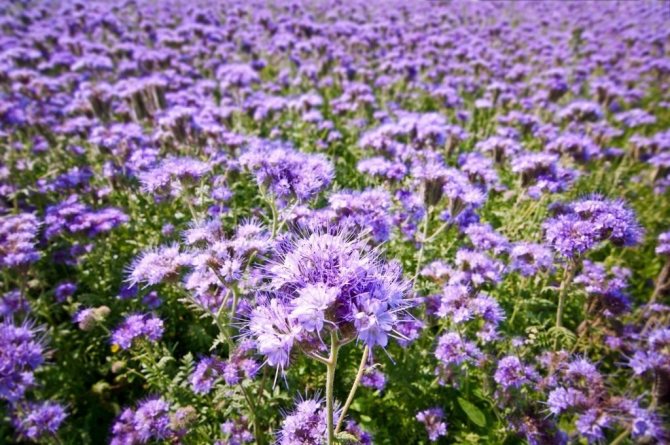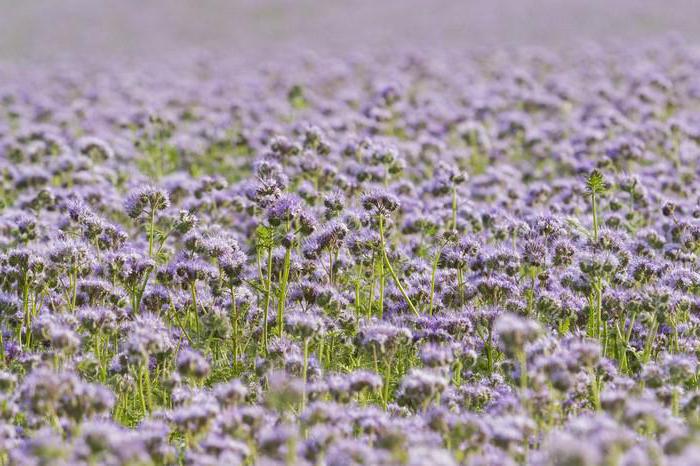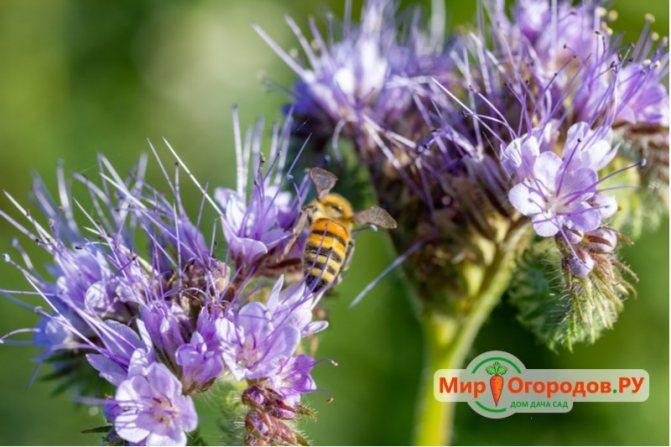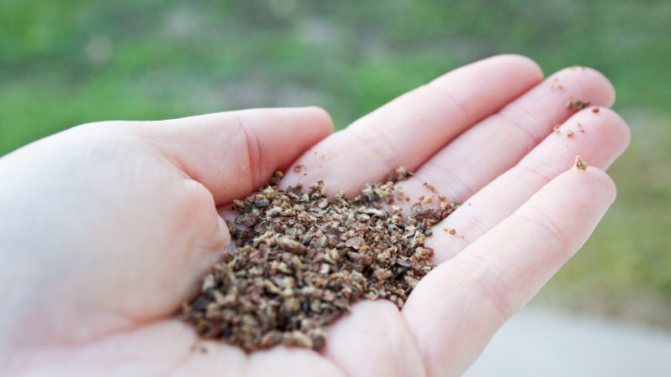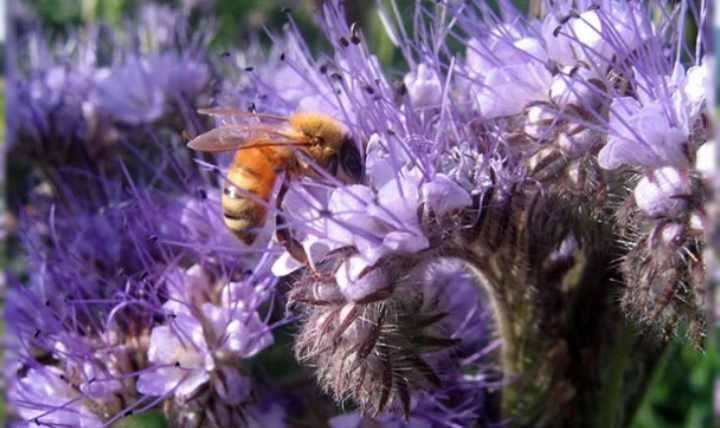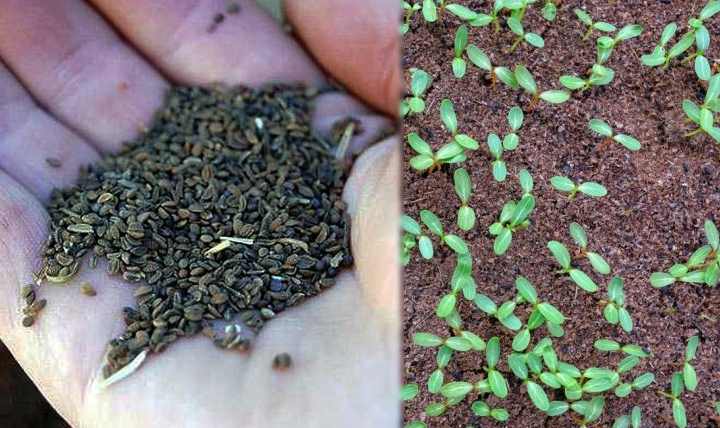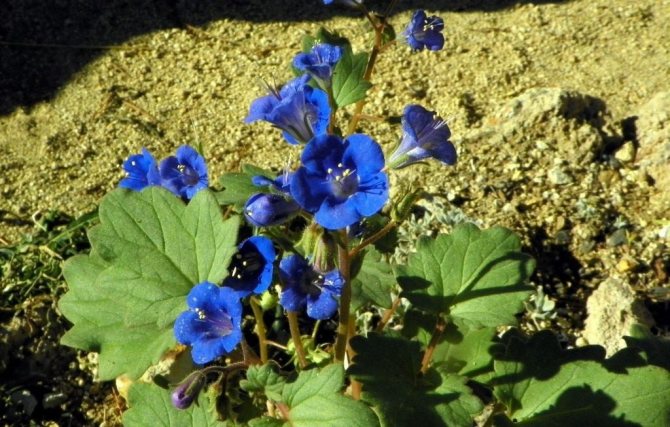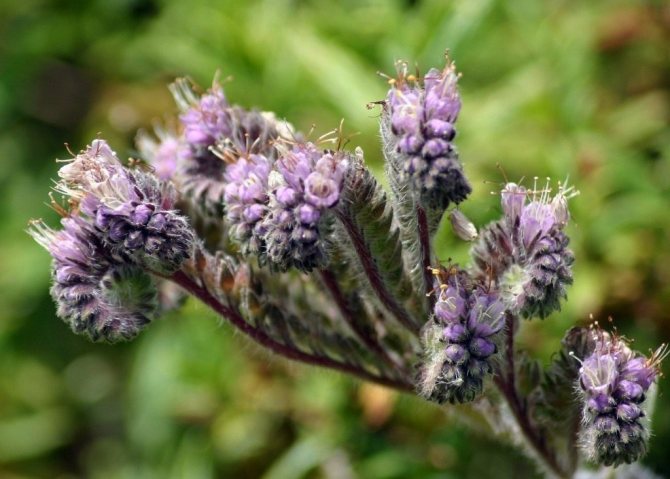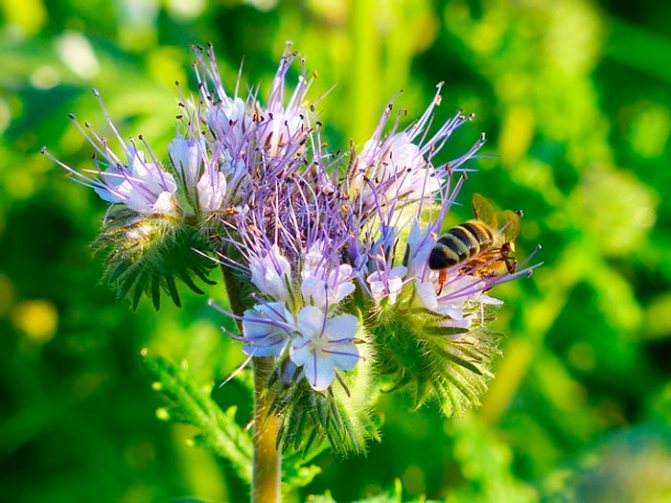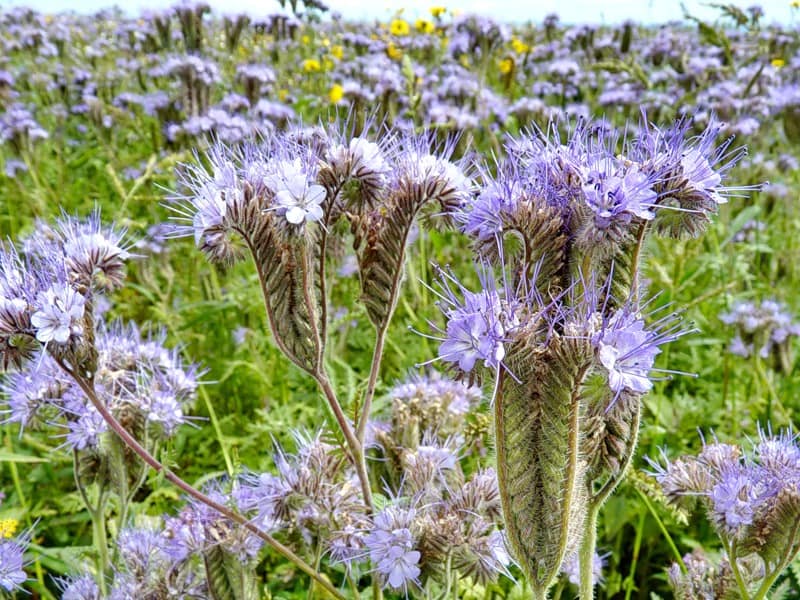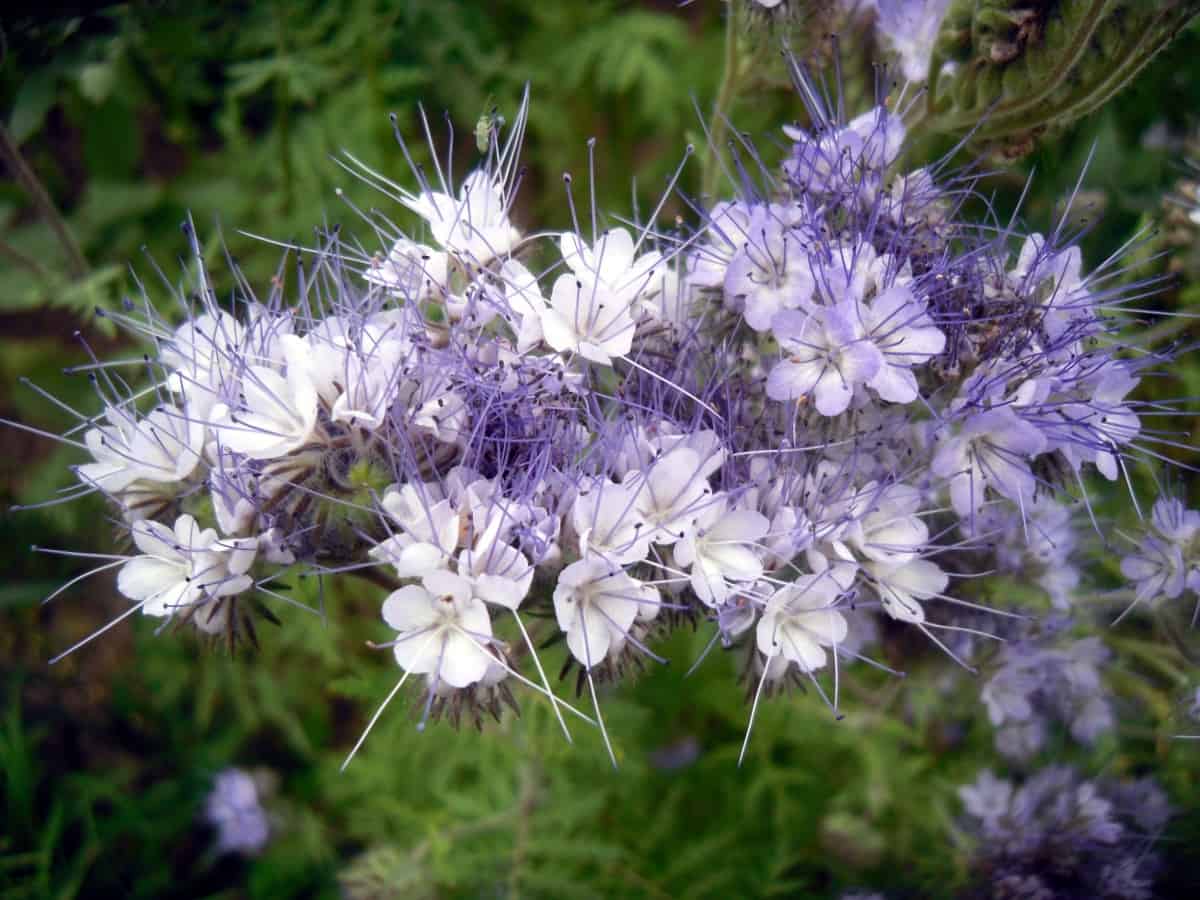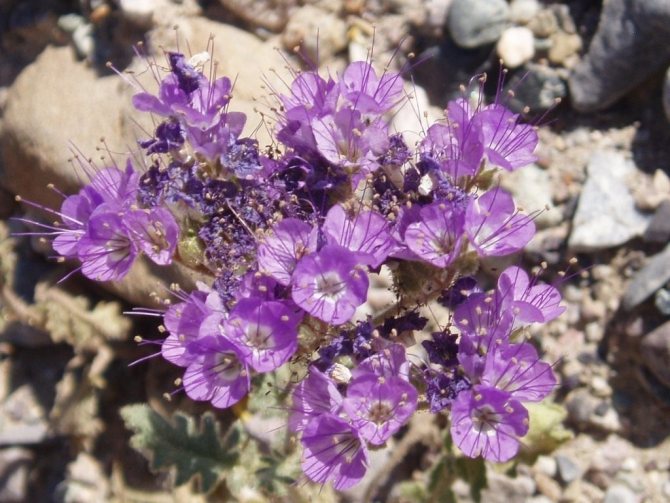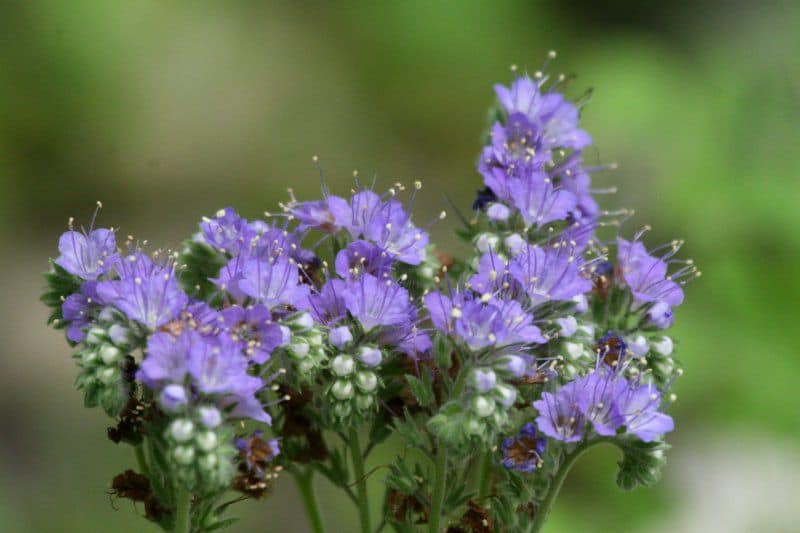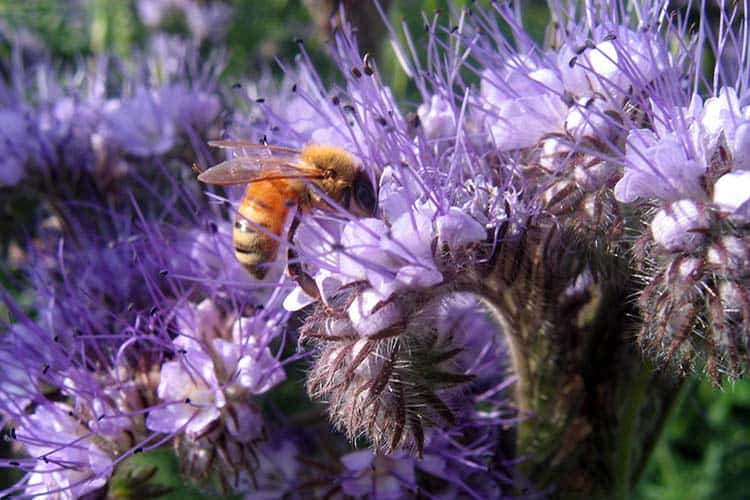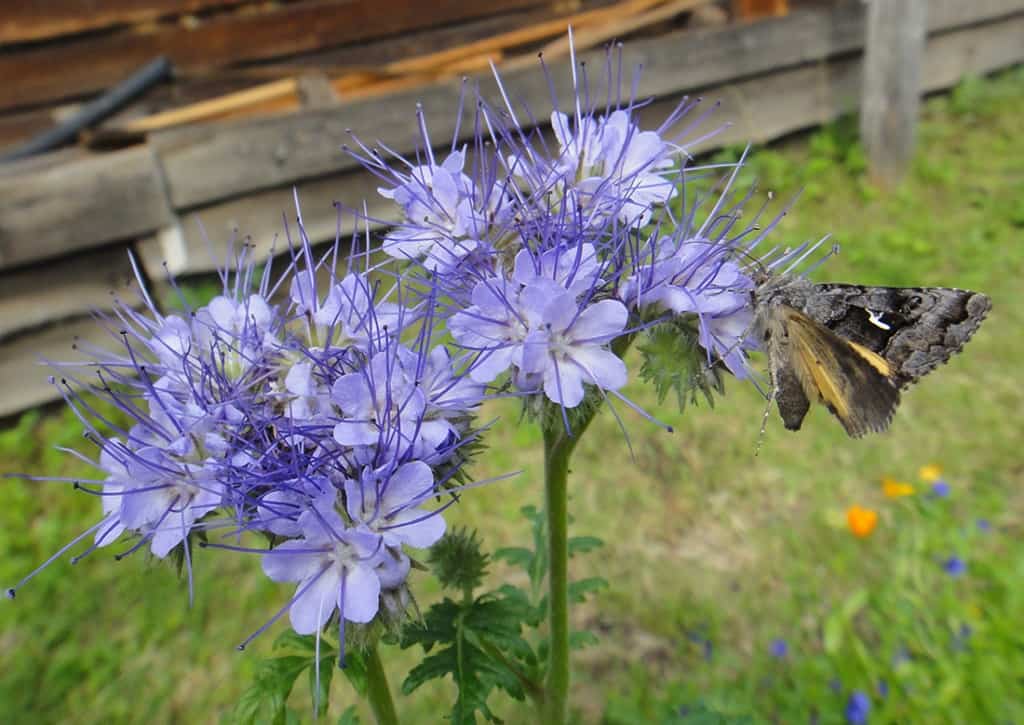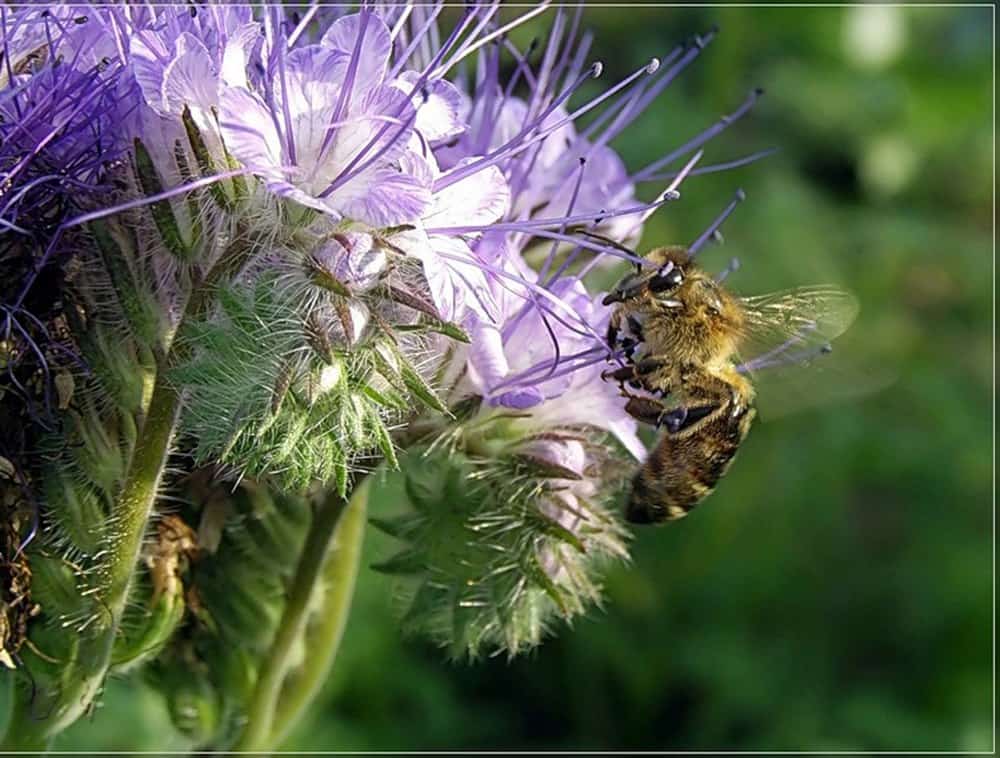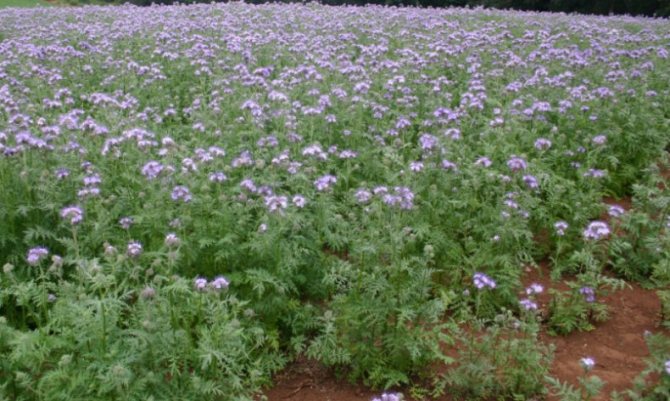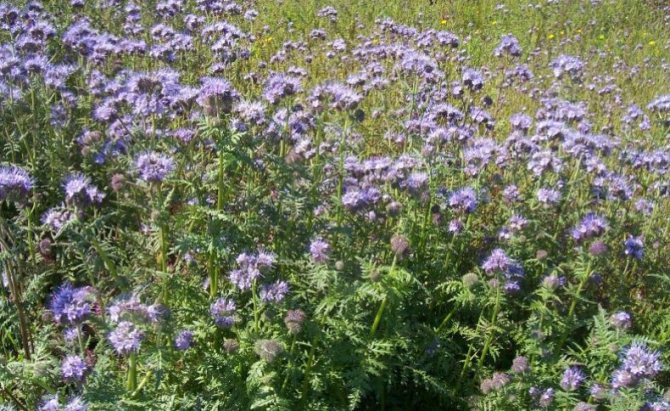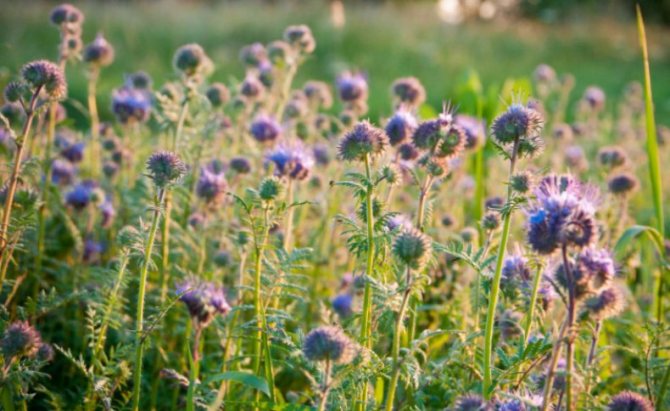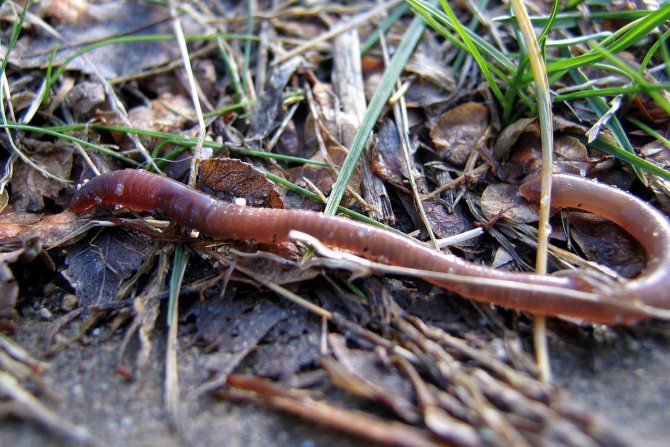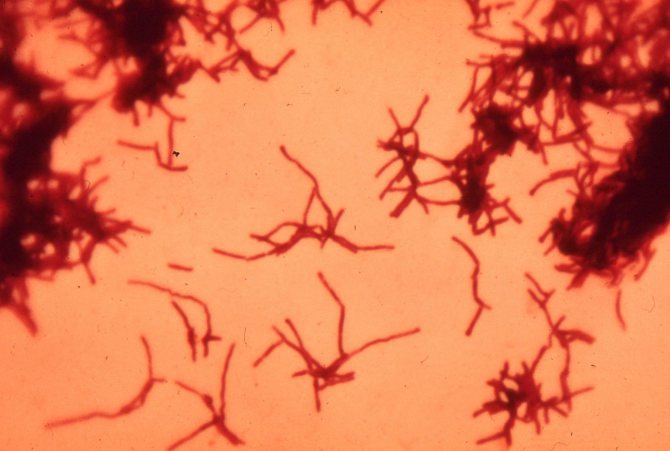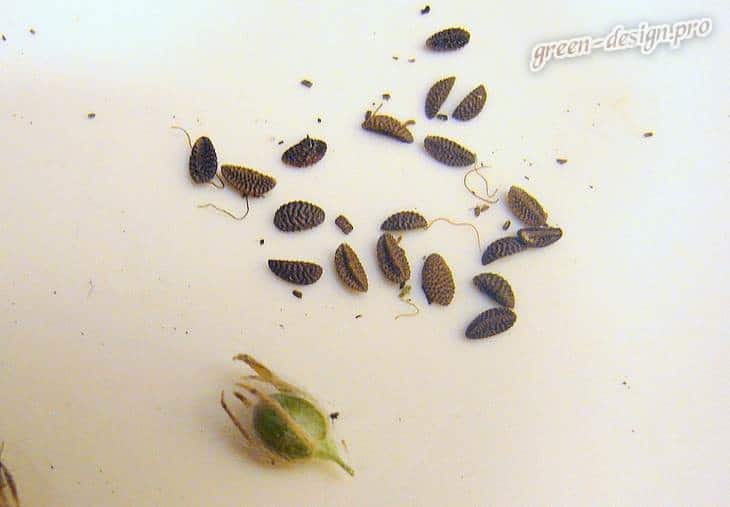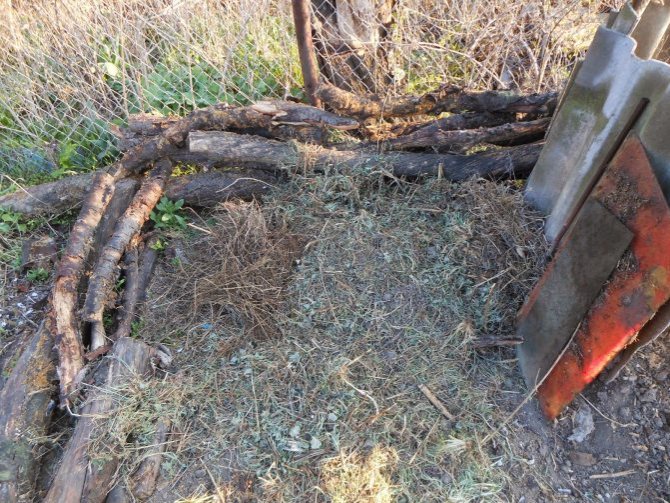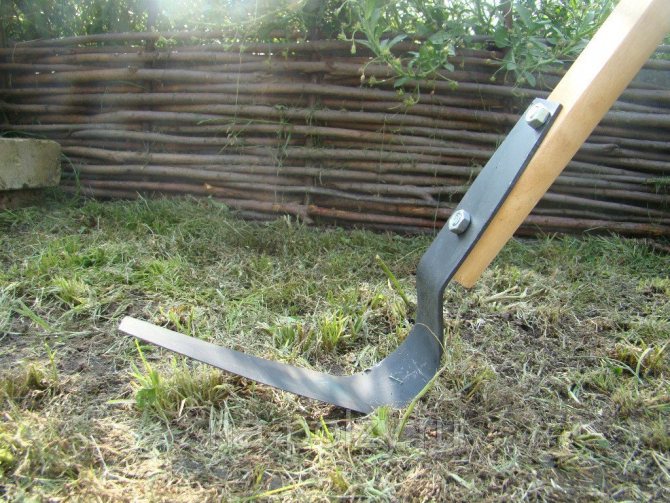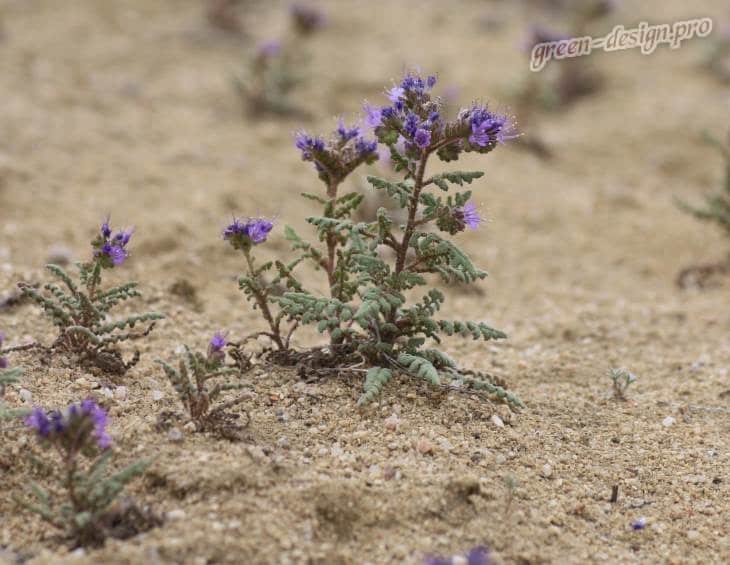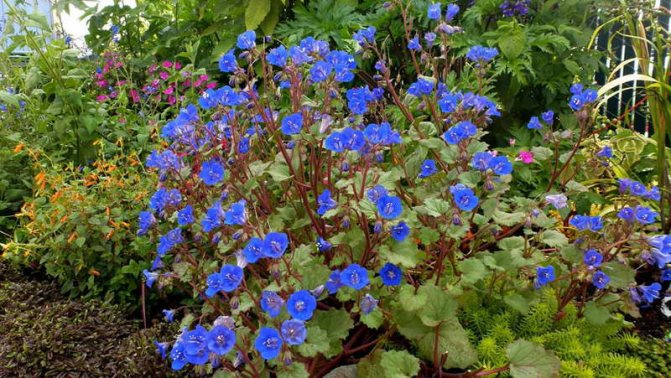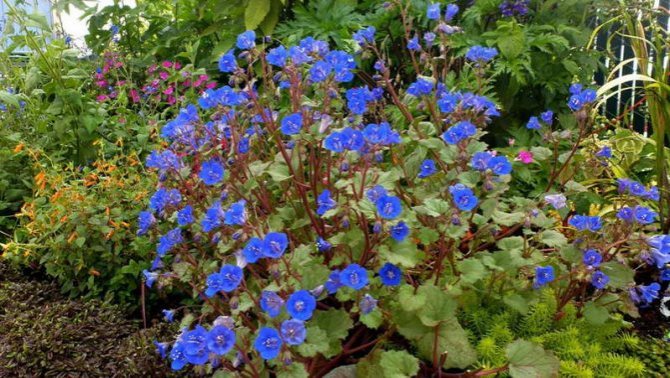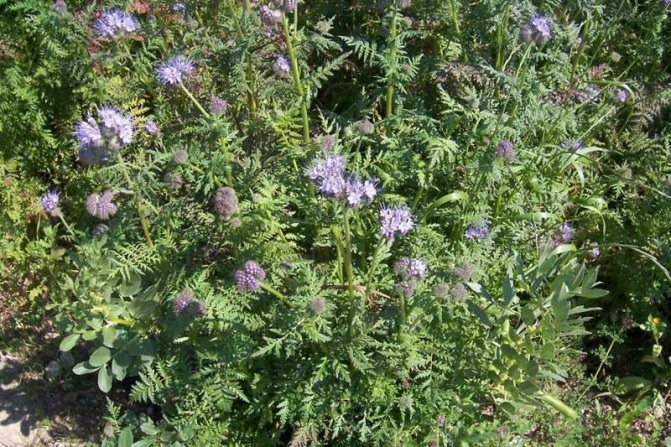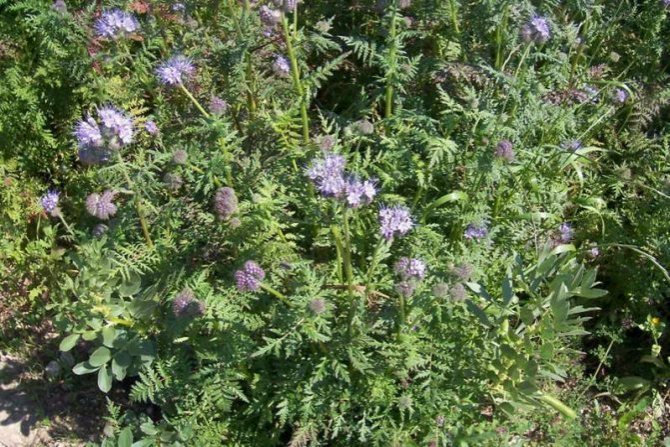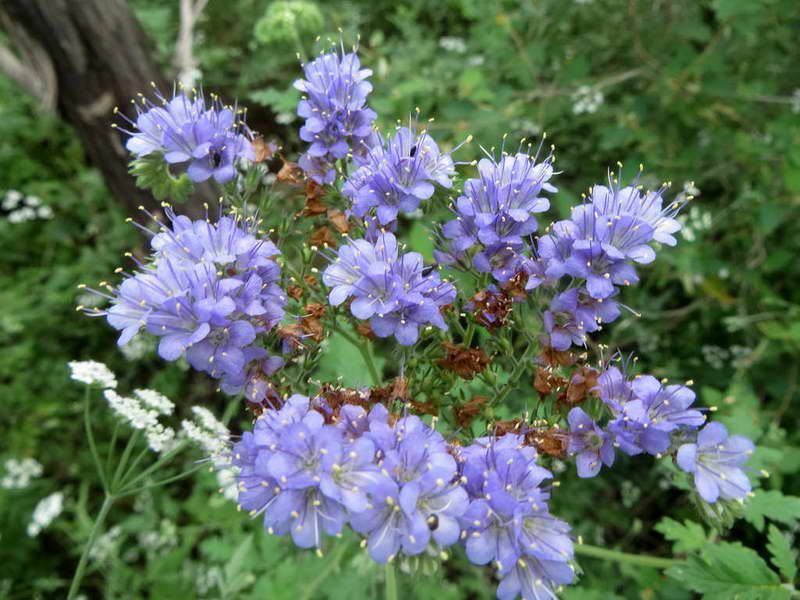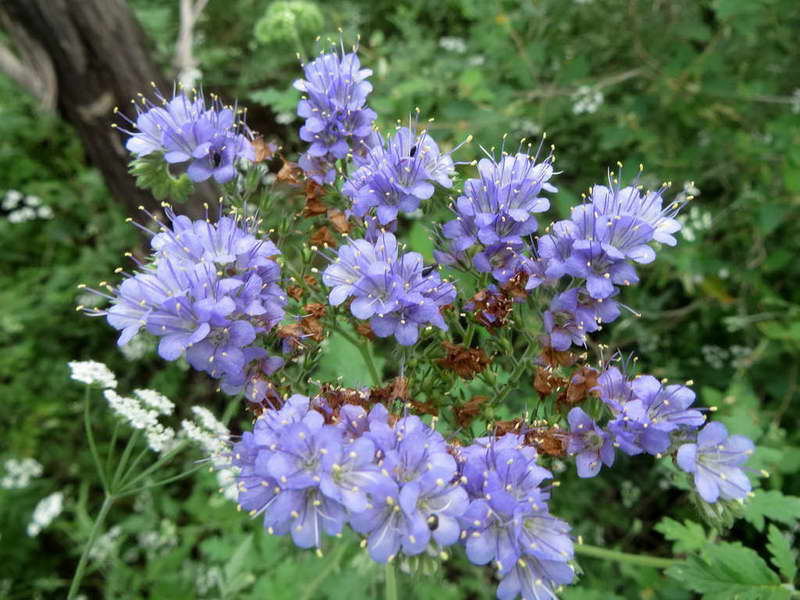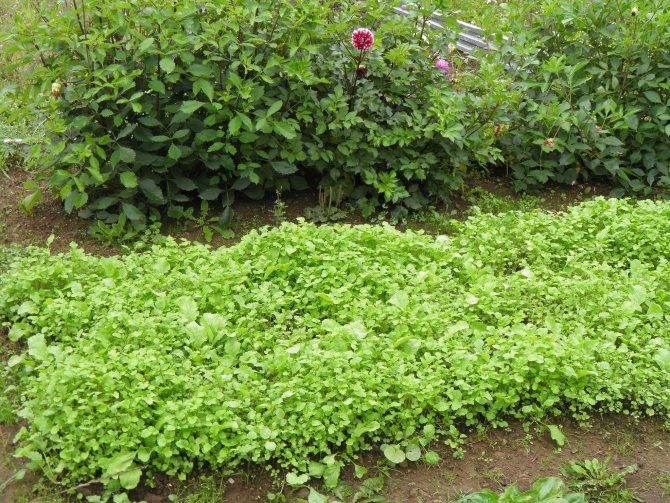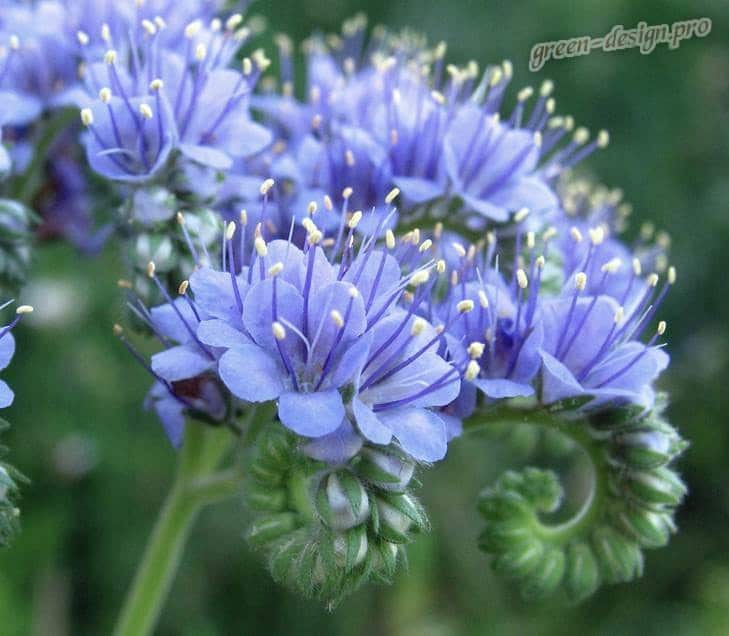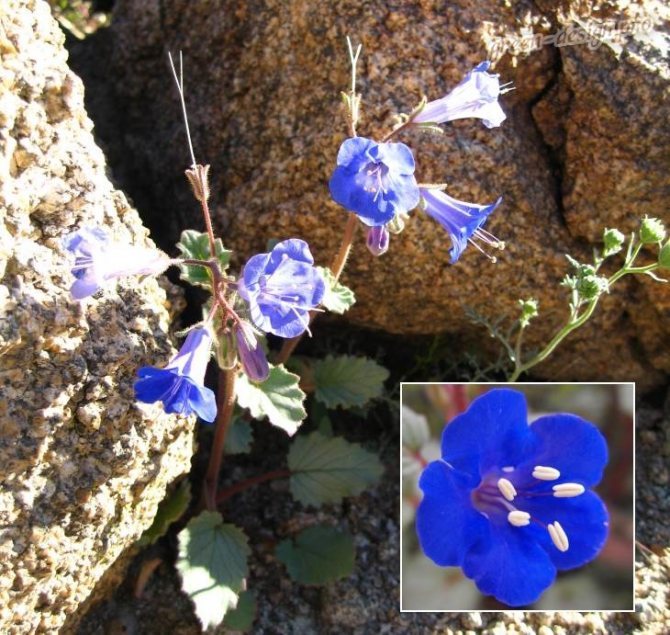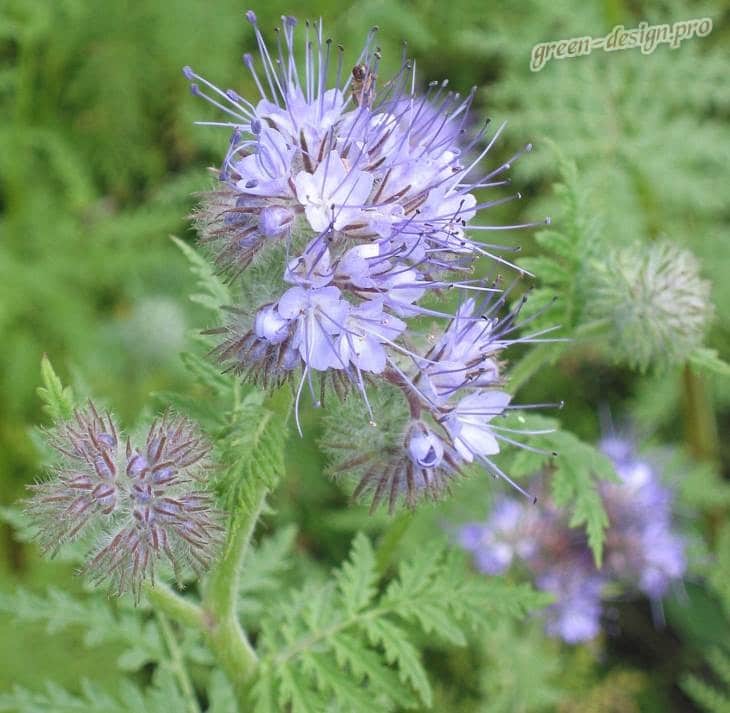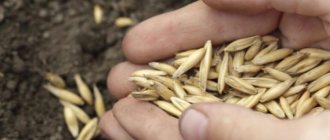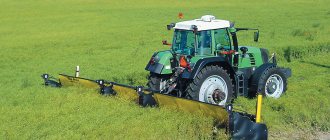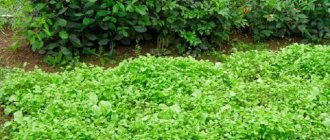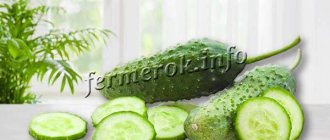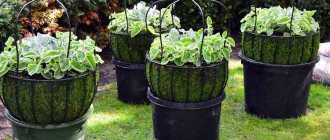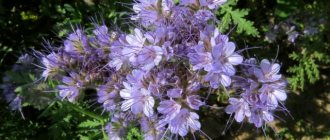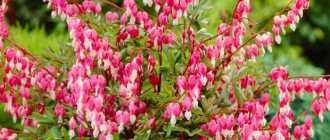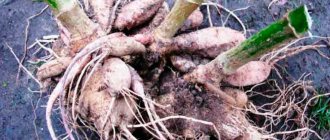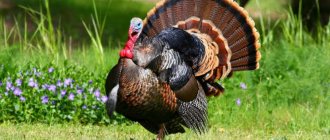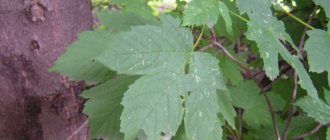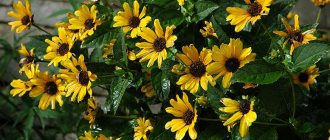The field of horticulture and agricultural technology, according to statistics, has made significant headway in recent decades. New varieties of plants, more improved crop processing devices, as well as new methods of processing and fertilization have appeared. This review is devoted to such a phenomenon of organic fertilization as phacelia: what kind of green manure it is, how to use it correctly, what are the features of growing this fodder crop - we will consider in more detail.
Fresh articles about garden and vegetable garden
What should be sown in February for seedlings?
Choosing a lamp for indoor plants and for illuminating seedlings
Find out what to sow for seedlings in January: what flowers, vegetables, berries, how to care for seedlings
What is Phacelia
Phacelia is an annual plant that belongs to the aquifolia family. Previously, it grew only in America, but in a few years it became known in Europe. If we talk about the name itself, then it means a bunch, namely flowers in an inflorescence. Now there are about 80 types of phacelia, but in our area three types are most often found: Bell-shaped, tansy and twisted (also called twisted).
The tansy species is often used as a siderat. The rest of the varieties will be more suitable for flower beds or for a plot near the house, due to the decorative appearance of the flowers and their long flowering.
Phacelia is an annual plant and grows about 1 meter in height. One bush can form about 20 lateral shoots, which end in bunches (namely, inflorescences with small flowers). The flowers themselves have a very pleasant and delicate aroma that attracts honey plants.
It is very interesting to observe the plant, because one flower blooms for about 2 days, but there are many flowers on one bush and they gradually bloom, creating the effect of constant flowering. Sometimes, gardeners will plant the plant as a beautiful addition to the garden or plot. Indeed, the plant looks unique and memorable.
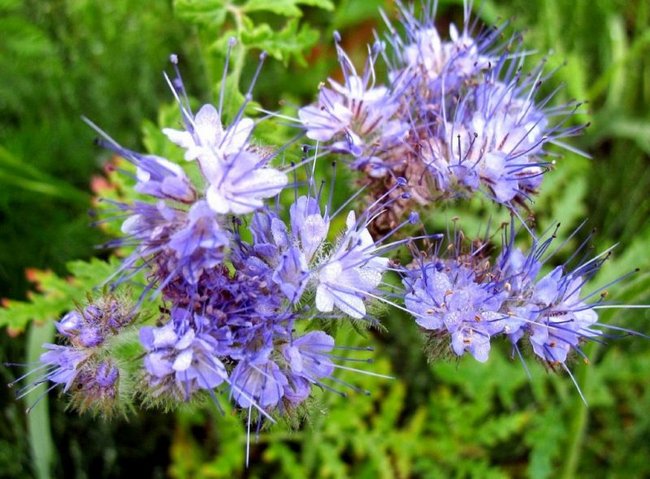
Variety of varieties
- Phacelia bell-shaped native to California, grows up to 25 cm. The stems of the plant are slightly reddish in color, fragile. Leaves are green-blue with brown edging. Inflorescences are formed by a brush, flowers in the form of a blue bell.
- Phacelia silvery Is a rare species that grows in northern California. Most often it can be found on the coastal area. Plant height reaches half a meter. The foliage is covered with a whitish edging, due to which the leaves have a silvery tint. The flowering is small, collected in small globular inflorescences.
- Phacelia twisted stretches 50 cm in height. Blue small flowers are collected in twisted inflorescences, the stems are covered with leaves densely located along the entire length.
- Tansy phacelia blooms in May. The inflorescences look like spikelets with blue-pink flowers. One-meter stems, together with leaves, are covered with fine pile.
- Phacelia Pursha interesting by the color of flowers. They have a white center and light pink edges; in nature, other combinations of shades of this variety are possible.
- Spear phacelia can be found in the United States, more often among coniferous forests. It blooms with small white or purple flowers. The height of the bushes is not more than 50 cm. Leaves with obvious veins and correct geometric arrangement, they are covered with gray fibers.
- Silky phacelia very popular in many parts of America.The stem does not branch, it grows up to 45 cm. Phacelia cultivar is covered with a silvery edge. Flowers have different colors, they look like lupine.
The properties of the phacelia are varied. Depending on the needs, it can be planted as fertilizer, or to attract insects. Outwardly, the plant is very beautiful, therefore it is often used to decorate flower beds and garden compositions.
Why use phacelia as a green manure
As a siderat, many gardeners prefer to use phacelia, which allows solving many phytosanitary problems:
Restoration of the fertility of depleted soils. The culture is able to master and fertilize any soil. As a result of the decomposition of the green mass, the earth is saturated with easily assimilable nitrogen, humus, organic matter, potassium, phosphorus, calcium and various microelements.
Improving soil structure. The branched root system of the phacelia goes into the ground to a depth of 0.2 m. At the same time, it splits the soil into small particles, thereby making it looser and more moisture-permeable.
Some rules
It should be said that not all conditions can be favorable for certain plantings. However, with some effort, using the right methods, high yields can be obtained fairly easily. If you do not know some of the features of growing "green fertilizers", you can make a number of mistakes, as a result of which all the work will go down the drain. In order not to be disappointed in the method of enriching the land with useful compounds by planting green manure, it is necessary to adhere to the following recommendations:
- Crops must be mowed on time. Otherwise, the stems will become rough, which will significantly slow down their rotting in the soil. Not completely decomposed biomass, in turn, can become a source of fungal and viral diseases.
- To protect vegetable crops from weeds, it is necessary to sow phacelia not in rows, but in bulk.
- Topping is done 2 weeks before the main plantings are planted.
- Plants that belong to the same family as phacelia and other green manure should not be sown next. This is due to the fact that common pests can persist in the soil.
- If the planting of a crop is carried out to restore fertility, then the "green fertilizers" should be mowed with a flat cutter or oblique, trying not to damage the root system.
- Winter green manures that were sown in late autumn are not recommended to be cut before the onset of frost. It is more expedient to leave them until next spring. In this case, there will be no need to plow the ground, since it will be quite loose anyway.
Features of growing phacelia
Since the plant is cold-resistant and can withstand frosts up to 10 degrees, it can be sown in early spring, as soon as the snow melts. The seed is also frost-resistant, so the air and soil temperature does not affect germination.
During the season, you can get fertilizer 4 times from planting phacelia. From the moment of sowing to the flowering phase of the tansy phacelia, a month and a half pass. Plants can be sown again immediately after mowing.
How to sow phacelia:
- the first time - the beginning of May;
- the second is mid-June;
- third - early August;
- fourth - mid-September.
If the bed is completely intended for green manure, then sowing and harvesting are carried out one after another. At the same time, the roots remain in the ground and rot. Green mass is applied:
- for the preparation of green fertilizer in a barrel for watering garden crops;
- for mulching beds;
- added to compost;
- goes to feed the animals.
Before the first spring planting, mineral fertilizers must be applied in the soil at the rate of 60 g per square meter so that the green manure has something to eat. These investments are not in vain, as they return to the soil in the form of organic fertilizer, rich in nitrogen, potassium and phosphorus.
Phacelia fertilizer
For the garden, like green manure, several varieties of phacelia are used.Tansy is the most common among them; you can also take twisted and bell varieties. Phacelia tansy reaches a height of one meter.
The versatility of the green manure properties of phacelia lies in the fact that it can replace several plants.
The main features are:
- undemanding to soil composition, adaptability to drought and good growth of tops even in the shade;
- you can sow at the beginning of spring, phacelia survives at 10 degrees of frost;
- thanks to the juicy stem and foliage, decomposition of the phacelia begins after instillation. Decaying in a matter of days, it nourishes the soil immediately;
- the plant is not exposed to pests, having bactericidal qualities, restores the soil after previous plantings, improves the condition of the following crops;
- when planting green manure with lentils or peas, the nitrogen content in the soil increases, the fungicidal effect is enhanced;
- phacelia tops are environmentally friendly, which guarantees the purity of the crops that grow after it;
- the soil after the green manure becomes slightly acidic, which prevents the growth of weeds;
- being a melliferous plant, the phacelia is planted where it is necessary to attract insects for pollination.
Features of care for green manure phacelia
There are only two main operations:
- Watering. It is necessary before germination if the soil dries out quickly. After the phacelia rises and begins to develop, it will have enough atmospheric moisture.
- Thinning. It will be required if the seedlings are too thick. The optimal distance between them is 5 cm.
If the phacelia is sown in a poorly treated, clogged area, one weeding may be necessary. Young shoots are too tender and will not cope with strong perennial weeds on their own.
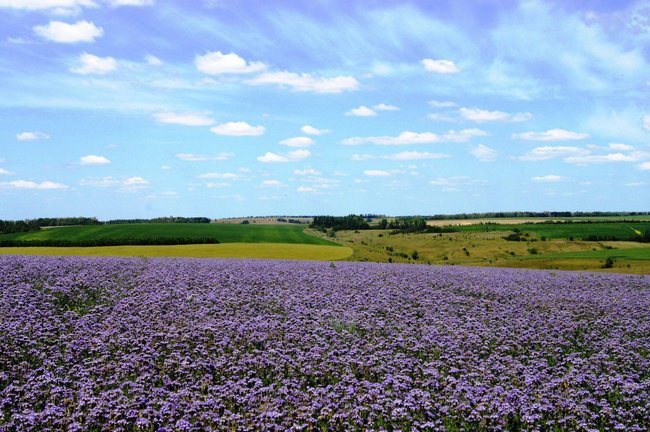

Fresh articles about garden and vegetable garden
Growing gloxinia from seeds at home
Growing lavender outdoors
Growing gladioli outdoors
Botanical description and birthplace of the plant
Phacelia (Phacelia) is a one - or perennial plant from the Borage family. In gardening, it is not widespread, however, at the sight of its sky-blue inflorescences, there is certainly a desire to grow a flower in a flower bed. In addition to beauty, the flower has useful properties: it is an excellent honey plant, green manure, phyto-sanitary and fodder plant.
In nature, phacelia grows on the continents of North and South America, and is cultivated all over the world. The height of erect stems fluctuates in the aisles of 25-100 cm. The plant develops rapidly and forms a nice fluffy bush. Shoots are especially fragile and juicy at the beginning of growth, in terms of feed for livestock - single-cut phacelia. The ribbed skin is covered with short villi; the closed flowers are also pubescent. Leaf plates are pinnately dissected or lobed, located quite close to each other, individual leaves are serrated, less often the edges can be whole. The leathery surface is veined.
Phacelia flowering on video:
Small buds of 40-100 pieces are collected in a spike-shaped inflorescence, twisted by a snail. They dissolve alternately, the curl gradually levels out. The corolla is in the form of a regular five-lobed bell; 5 long stamens protrude from its center. A single flower lives no more than 2 days, however, during season 1, the plant produces 20-40 peduncles. The total number of corollas ranges from several hundred to one thousand. Sky blue, blue, purple colors create an atmosphere of serenity. From Latin, the name of the plant is translated as "bunch", because the phacelia has a lot of flowers.
When the phacelia blooms
Flowering starts in early summer and lasts until mid-autumn. This gives the pollinating insects a lot of time to collect the nectar.
The smallest seeds ripen in capsule fruits (1 g contains about 2000 pieces).
When to mow the phacelia
It is very important not to miss the moment of harvesting the phacelia, since otherwise the leaves and shoots of the plant are roughened, which slows down the decomposition process in the soil, and also, in the case of seed ripening on the root, contributes to the uncontrolled growth of the phacelia throughout the entire plot.
To obtain a juicy, soft green mass, the phacelia is mown before flowering. During this period of the life cycle, plants accumulate the maximum amount of trace elements and mineral salts. You can mow the grass with a lawn mower, an ordinary scythe, a sickle or a flat cutter.
In late spring, in June and July, the phacelia is mown completely. Some gardeners mow, leaving a third or half of the stems with leaves.
The grass is left on top of the soil (if mulch is needed), or embedded in the soil. The green mass buried in the ground immediately begins to decompose and gives up all the useful substances; if it dries on the surface, this process is much slower.
Autumn phacelia planted after harvesting is not mowed, since in winter, thick grass protects the soil from low temperature and wind.
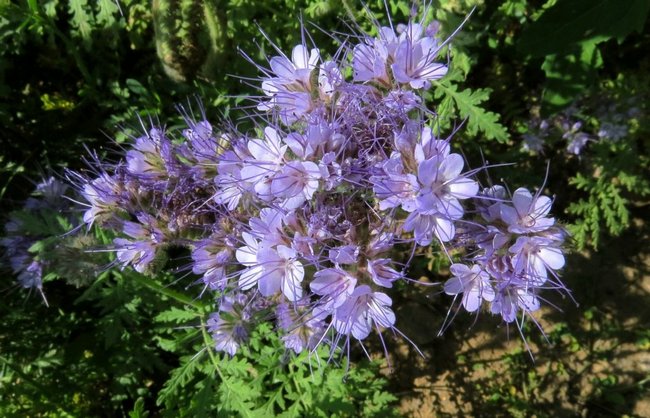

The use of phacelia as a green manure is very beneficial, since it allows you to improve soil fertility and clean up the site without additional costs for the purchase of mineral fertilizers.
An important point
Do not overtighten with the incorporation of green mass. It is more expedient to carry out this work within the first week from the beginning of flowering. First of all, grooves should be dug in the aisles. Their depth is about 10 cm. After that, it is necessary to cut the plant slightly below the soil and lay the greens in the prepared furrows. Organic matter should be lightly sprinkled with compost or garden soil. Some summer residents simply mow the phacelia with a sharply sharpened flat cutter, deepening it 2-3 cm below the soil surface, and then leave the greens to decompose right on the garden bed.
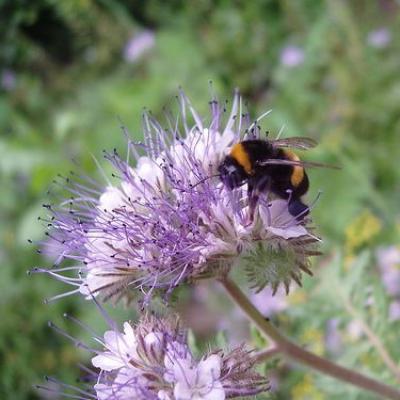

Useful properties of phacelia for soil
If you apply this type of green manure once, then the effect will be positive. Better yet, do it regularly. Only in this case it is possible to achieve the following positive shifts:
- The soil will be loosened and saturated, respectively, with oxygen and water.
- This culture prevents weeds from spreading intensively.
- Optimizes acid-base composition.
- Saturates plantings with nitrogen and organic matter. Thanks to this, it is possible to replace the introduction of manure with this green manure.
- Thanks to the phacelia, wireworms, nematodes and locusts will disappear from the site.
- The growth of putrefactive and fungal diseases on the site is reduced.
Phacelia nectar attracts predatory carnivorous insects. Thanks to these aggressive predators, breeding moths, leaf rollers and other pests are reduced on the site.
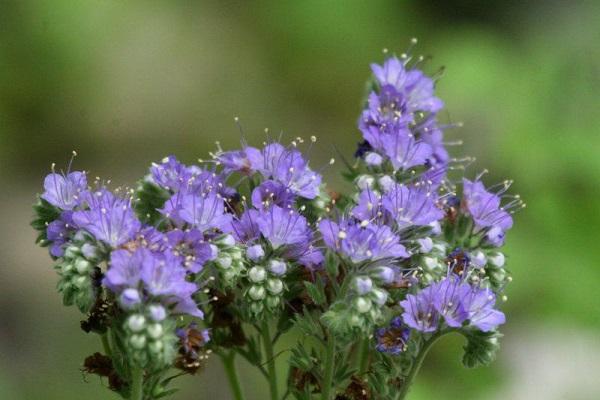

When to sow green manure in autumn
The autumn period is rather short for the vegetation of plants. Therefore, the choice of green manure crops for autumn sowing is reduced. They are sown immediately after harvesting early and mid-season varieties of potatoes, cabbage, onions and other vegetables. Planting of green manure in the fall is carried out in free areas.
Mustard
Mustard seeds sprout quickly and amicably in the fall. To sow them, you need:
- Choose a site where cruciferous plants (cabbage, radish, lettuce, etc.) are not planned to be planted next year;
- Prepare a small amount of seeds;
- Scatter seeds in the area with their obligatory deepening into the soil or sow in even rows.
Mustard is sown immediately after harvesting different crops, from August to October. Crop maintenance is not necessary. In two weeks the garden will be covered with lush greenery. If the autumn days are warm, the mustard manages to throw out the buds and bloom.
The green mass is mowed a few days before digging or plowing and removed from the site. On virgin soil, which is cultivated in spring, the cut grass remains in the form of mulch, enriching the topsoil with phosphorus fertilizers.
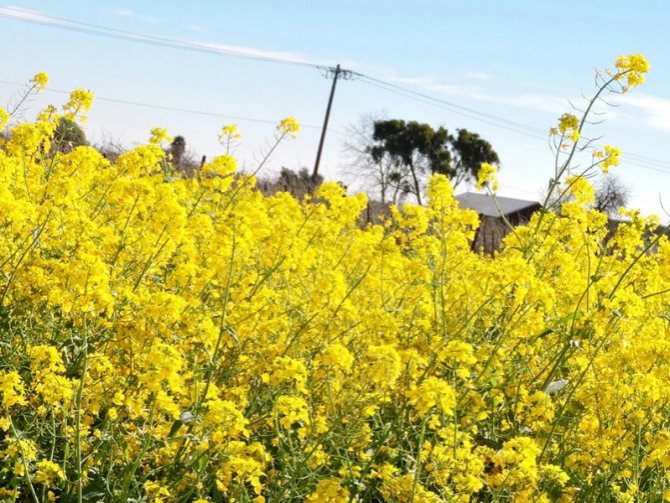

For full development and growth, the plant requires potassium. It is introduced into the soil together with organic fertilizers, which can be replaced by cereal green manure - oats.
In late autumn, before plowing, green shoots can be mowed and removed from the site. The green mass in the form of mulch will be beneficial without the need for organic fertilizers. In the spring, the oat-planted area is plowed along with the green stalks of the oats.
If the cereal plant has given a strong growth, the stems are mowed and removed from the site. The green mass is used for feeding animals or left for mulching the area.
Winter rye, like green manure in autumn
On land where loosening is not planned for the winter, winter rye will be a suitable crop for fertilization.
The culture is sown in October so that the grain has time to germinate in the soil and create a rosette before the cold weather begins. Sowings of rye are used to loosen the topsoil and enrich with potassium.
Green mass that has reached a height of 20-40 cm, mowed in late autumn and removed from the field before plowing. Most often, winter rye is left for the winter, so that the plant has time to give amicable shoots for spring mowing.
When to sow phacelia in autumn
Phacelia belongs to the group of green manure, which is sown from early spring to late autumn. The plant is considered a universal predecessor for any garden or field crop. In addition, blooming phacelia becomes attractive to bees.
Read also How many calories are in apple jam
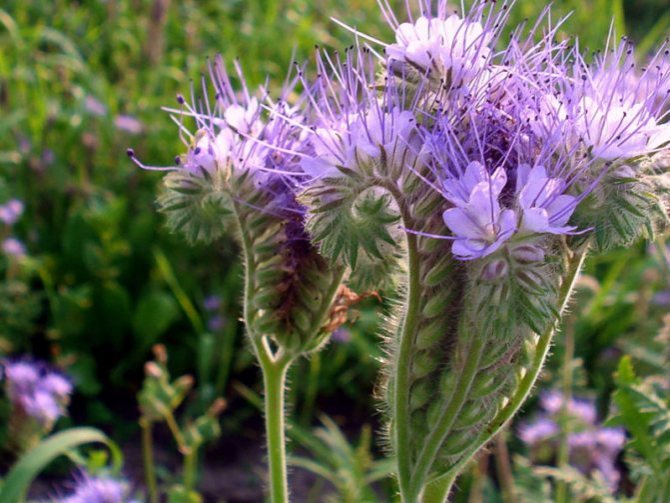

Fall crops of phacelia are carried out during the rainy season, since small seeds require moisture. Seeds are scattered in scattered or even rows, always covering them with earth. The green mass is growing quite quickly.
Choosing green manure before winter
Similar articles
Sowing time
Baikal - EM1
What to sow green manure?
When it comes time to plant seedlings, I do it right in the beds with phacelia. I prepare the holes, freeing up small rounded areas for each plant. I plant seedlings of cabbage, tomatoes, peppers, eggplants, celery. I cover the trunk circle with a torn phacelia, like mulch. This trick allows you to shelter the seedlings from the wind, the scorching sun, and retain nutrient moisture. A week later, when the seedlings take root, I cut off the phacelia greens with a flat cutter and cover the garden with it.
Phytosanitary properties
To increase the yield of tomatoes and cucumbers, they are planted on an area sown with phacelia. Holes are made in the beds, seedlings are planted in them.
Phacelia releases phytoncides during its growth. It disinfects the soil, retains moisture, attracts bees and discourages parasites. Because of this, vegetables do not get sick, grow faster, and give a rich harvest.
Seeds of honey plant are scattered around shrubs and trees to disinfect the soil and pollinate plants.
How to apply - under what crops
For each vegetable, there are special recommendations on how best to sow phacelia. Suitable for most vegetables. For some, it is not even necessary to mow green manure - you can plant between green manure.
Phacelia and tomatoes
You can plant tomato seedlings right between plantings of green manure plants. You can not mow it, but wait until the seedlings take root. In the spring, when the weather has not yet improved, and the seedlings are small and are being transplanted into open ground, phacelia thickets shelter them from the wind, protect the root system from pests and rot.
When the tomatoes grow up, the root system is left to rot, and the top is cut off and placed under the tomato bushes. This helps to maintain moisture. You can put a layer of straw on top so that the mulch will rot as well.
During the entire growing season, the main crop - tomatoes - will be provided with nutrients and moisture. After harvesting, you can use the green manure mixture and sow the area after the tomatoes with phacelia and mustard.
Phacelia and potatoes
To enrich the soil with nitrogen and phosphorus, it is necessary to combine autumn and spring planting of green manure. Phacelia in this case is best sown in the fall, and nitrogen-fixing peas, beans - in the spring before the very planting of tubers.
When to sow phacelia in autumn and when to cut green manure depends on the climate conditions. If it is southern and warm, you can sow in October. Seedlings will die and rot in winter. In the spring, legumes are sown in their place, they wait until the plants gain green mass - 1 month, cut and dug up with the soil. You need to wait 2 weeks for the plant residues to rot. Then potatoes are planted.
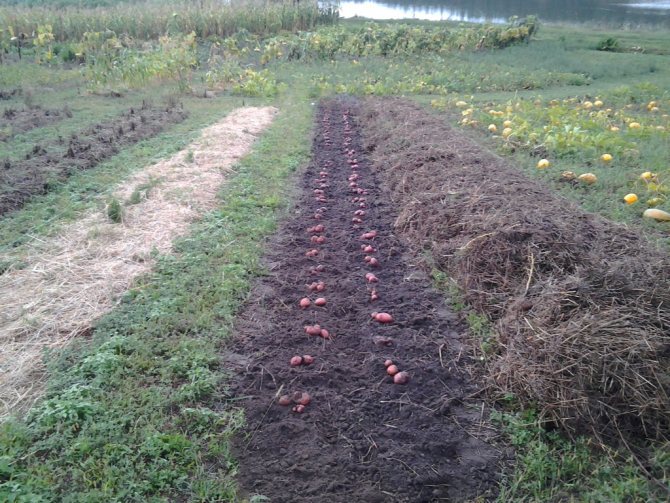

A mixture of phacelia and legumes 50x50 goes well for potatoes. Legumes attract nitrogen, which is good for tubers; phacelia protects them from wireworms and other insects. Siderata are sown in strips next to potato bushes.
Phacelia and melons - cucumbers, pumpkin
Cucumbers greatly deplete the soil, taking out a lot of nutrients from it. If you use only green manure farming, then planting is needed both before and after cucumbers.
Sowing green manure phacelia in front of cucumbers in spring means protecting them from nitrogen starvation, suppression of the root system due to a lack of phosphorus, and the loss of ovaries due to potassium deficiency. The lack of any element leads to the incidence of fungus. Cucumbers can be grown in one place several times in a row only in the presence of phytosanitary, such as mustard, phacelia, rye.
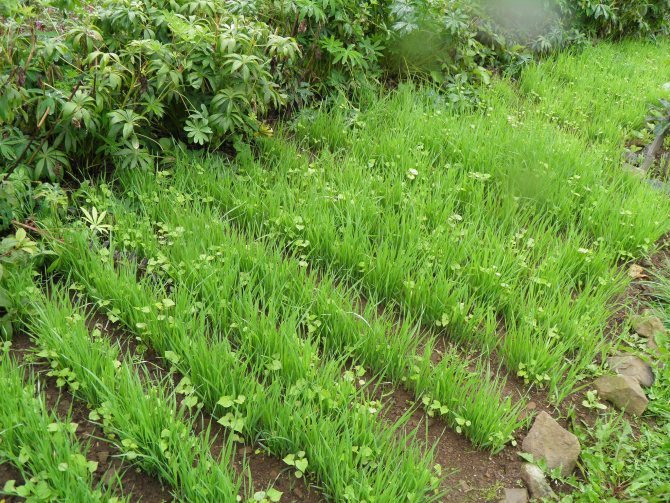

After harvesting, you need to disinfect the soil. Siderates are sown, which inhibit the development of pathogenic microflora.
Phacelia and cabbage
Cabbage seedlings can be planted in the holes between the phacelia. It is not recommended to use cruciferous green manure so that the cabbage does not get sick. After the cabbage has taken root, the phacelia is cut at the root and the soil is mulched between the rows. Roots, rotting, serve as food for vegetables, and greens retain moisture and also give nutrients to the soil. With a large amount of greens, it is used for fermentation in barrels and the garden is watered with a solution.
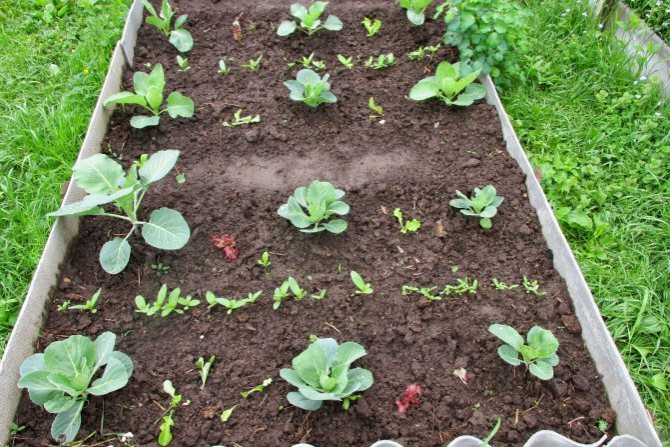

Strawberries, raspberries and phacelia
Berry crops benefit from the proximity of phacelia and other green manures, because they attract bees for pollination. Productivity increases, as barren flowers on strawberries, raspberries, blackberries are practically absent.
The best plant fertilizers for strawberries are lupine and phacelia, as well as legumes with their ability to accumulate nitrogen and give it to nearby plants. If strawberries have not yet grown on the site, but only planted bushes, then before spring or autumn planting of strawberries, it is recommended to sow siderates to improve the quality of the soil and enrich it with nutrients.
Before planting the bushes, siderates are mowed, strawberry bushes are planted in the garden, then mulched with green shoots and leaves. For good rooting, it would be good to put sawdust or straw on top of the phacelia. Such a layer protects the soil from drying out and drives away pests. Berries remain dry when ripe and are less likely to be damaged by spores of the fungus that travels through the air.
Sowing greenhouse greenhouse in spring
General principles and requirements for greenhouse greenhouse cultivation practically do not differ from similar work in open areas. However, there are some peculiarities.
- Polycarbonate structures will allow you to start sowing already at the end of February.
- In film greenhouses, these terms will slightly shift to warmer months, not earlier mid-March.
When to sow?
Greenhouse conditions allow sowing throughout the spring. The optimal timing is the period April May, although you can start much earlier, already from the end of February.
How to sow?
In comparison with the autumn sowing, some peculiarities should be adhered to here.
- In winter, add some snow to the greenhouse. This will greatly facilitate the work, eliminating the need for mandatory watering before sowing seeds.By thawing, the snow will provide the soil with the necessary moisture for successful seed germination.
- Loosen the soil to a depth of 5-7 cm.
- Make furrows along the entire length of the planned bed. Can also be sown scattered over the surface.
- After watering (if you forgot to bring snow), you should sow the seeds of the future green fertilizer and sprinkle with soil.
- As soon as the green mass rises 20-30 cm above the soil surface, it must be cut and dug up. The main thing is to prevent the flowering and insemination of the green manure culture.
The cut green part of the plants will quickly rot, providing the necessary nutrition for future vegetable plants.
What to sow in spring?
As spring green manures, the following are most preferable:
- phacelia,
- oats,
- spring rapeseed.
These crops can gain a rich green mass in a fairly short period, quickly rot after cutting, forming the necessary amount of nutrients necessary for the future harvest.
| IMPORTANT After mowing green manure plants for complete decay, it is necessary to wait at least 2 weeks before planting the main crops. |

